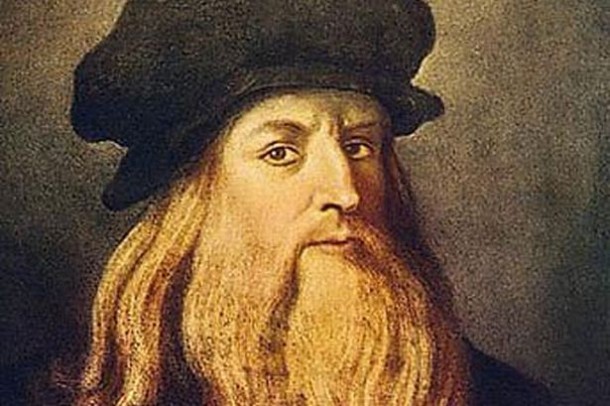Sigmund Freud once said that the great Renaissance Leonardo da Vinci was “like a man who woke up early in the darkness, while everyone else is still asleep.” He is widely considered to be one of the greatest painters of all time and perhaps the most diversely talented person ever to have lived. His innovations in the field of painting influenced the course of Italian art for more than a century, after his death.
Leonardo di ser Piero da Vinci or Leonardo da Vinci was an Italian painter, sculptor, architect, musician, mathematician, engineer, inventor, anatomist, artist, geologist, cartographer,botanist, and writer. He was a leading artist and intellectual of the Italian Renaissance who’s known for his enduring works “The Last Supper” and “Mona Lisa.”
Leonardo Da Vinci was the first to explain why the sky is blue.
Born on April 15, 1452, in Vinci, Italy, Leonardo da Vinci was concerned with the laws of science and nature, which greatly informed his work as a painter, sculptor, inventor and draftsmen. His ideas and body of work—which includes “Virgin of the Rocks,” “The Last Supper,” “Leda and the Swan” and “Mona Lisa”—have influenced countless artists and made da Vinci a leading light of the Italian Renaissance. Da Vinci’s most well-known painting, and arguably the most famous painting in the world, the “Mona Lisa,” was a privately commissioned work and was completed sometime between 1505 and 1507.
It’s been said that the Mona Lisa had jaundice, that she was a pregnant woman and that she wasn’t actually a woman at all, but a man in drag. Based on accounts from an early biographer, however, the “Mona Lisa” is a picture of Lisa Gioconda, the real-life wife of a merchant, but that’s far from certain. For Leonardo, the “Mona Lisa” was forever a work in progress, as it was his attempt at perfection. The painting was never delivered to its commissioner; Leonardo kept it with him until the end of his life. Today, the “Mona Lisa” hangs in the Louvre Museum in Paris, France and is regarded as a priceless national treasure.
Leonardo da Vinci could write with one hand, and draw with the other at the same time!
Leonardo’s most famous painting of the 1490s is “The Last Supper”, painted for the refectory of the Convent of Santa Maria della Grazie in Milan. The painting represents the last meal shared by Jesus with his disciples before his capture and death. It shows specifically the moment when Jesus has just said “one of you will betray me”. When finished, the painting was acclaimed as a masterpiece of design and characterisation, but it deteriorated rapidly, so that within a hundred years it was described by one viewer as “completely ruined”.
Contact lenses were first proposed by Leonardo Da Vinci in 1508.
His genius, perhaps more than that of any other figure, epitomized the Renaissance humanist ideal. Leonardo has often been described as the archetype of the Renaissance Man, a man of “unquenchable curiosity” and “feverishly inventive imagination”. Leonardo was, and is, renowned primarily as a painter. Among his works, the Mona Lisa is the most famous and most parodied portrait and The Last Supper the most reproduced religious painting of all time. Among the qualities that make Leonardo’s work unique are the innovative techniques which he used in laying on the paint, his detailed knowledge of anatomy, light, botany and geology, his interest in physiognomy and the way in which humans register emotion in expression and gesture, his innovative use of the human form in figurative composition, and his use of the subtle gradation of tone. All these qualities come together in his most famous painted works, the Mona Lisa, the Last Supper and the Virgin of the Rocks.
Despite the recent awareness and admiration of Leonardo as a scientist and inventor, for the better part of four hundred years his fame rested on his achievements as a painter and on a handful of works, either authenticated or attributed to him that have been regarded as among the masterpieces.
Leonardo DiCaprio’s name is Leonardo because his mother was standing in front of a Leonardo Da Vinci’s portrait when he first kicked.
Leonardo da Vinci may well have been the greatest inventor in history, yet he had very little effect on the technology of his time. Despite this, the painting has remained one of the most reproduced works of art, countless copies being made in every medium from carpets to cameos. Leonardo Da Vinci drew sketches and diagrams of his inventions, which he preserved in his notebooks, but either he lost interest in building them or was never able to convince one of his wealthy patrons to finance construction of his designs, because he never published his diagrams, nobody else knew about them until his notebooks were discovered long after his death.
That’s a pity, because Leonardo da Vinci’s designs were spectacularly ahead of his time. If they had been built, they might have revolutionized the history of technology, though many of them may have been impossible to build with the tools available in the 15th and 16th centuries. His notes and drawings display an enormous range of interests and preoccupations, some as mundane as lists of groceries and people who owed him money and some as intriguing as designs for wings and shoes for walking on water.

